|
June 14 – Saturday--On Our Way
We grab a quick, limited breakfast and then dash about attending to last minute emails, packing, taking the trash out, etc. Brian and Amy and Zion pick us up to go to the airport at 8:45. (Amy and Zion are going on to L.A. to spend the day with Jeanie and Madison.)
Our flight for Atlanta on Delta leaves right on time (10 a.m.) and completely full. I sit next to Daniel, an adorable 5 year old and his mom. I watch Veronica Mars – an odd empowered woman detective movie and then have some fun with Daniel.
We arrive in Atlanta and find a taco place at the airport to have a not-so-very-good taco. The plane for Amsterdam is overbooked – but on time. I have a very bad seat in the middle section wedged between Bill and an extremely fat guy. He is reading Michael Pollan’s book about food and considering doing something about his diet. The book must not have made a big impression on him because in the middle of the night, he offers to share his Hersey Bars with me – I accept. He is very sweet, but can’t help but spill over into my seat. He also has some sort of tick causing that motorized automatic shaking in his left foot. The constant shaking reverberates into his upper body. I feel as though I’m being attacked by giant blob of vibrating jello. Needless to say, in spite of the Ambien pill, I get no sleep. I watch about 4 movies – The Grand Budapest Hotel, The Lego Movie, Billy Jean King documentary and something else that really doesn’t matter.
June 15 – Sunday Arrive in Helsinki
The sun comes up and a happy flight attendant brings us egg muffin sandwiches and coffee. It is Father’s Day somewhere in the world – so I give Bill the card I made for him – a picture of Molly giving him kisses. Makes me laugh and miss Molly – hope Papa likes the card!
We arrive in Amsterdam about 10:30 am – I am a mess. The next flight is our last flight (also full) on this leg of the journey. We only have a short, 2 ½ hour jump over to Helsinki. We arrive in Helsinki at 5:30 p.m., gather our bags and meet Yulia, our guide. It is Sunday night and there is very little traffic to the hotel. Helsinki is a delightful, efficient, happy town – don’t know how else to describe it.
The hotel, Scandi Grand Marina, is right down by the water. We settle into our comfy hotel – an old warehouse that was once used to store coffee brought here by fleets of ships in the 1800’s.

Hotel Grand Marina |

Hotel Grand Marina |
Most places in Helsinki are right down by the water. Helsinki is built over peninsulas, curves around bays and spills out across islands that are linked by bridges, causeways and boats of all descriptions. Helsinki was named the 5th most livable city in the world – and I believe it! It’s a very efficient compact city with a population of about 612,000 offering parks and water galore!
We only have 45 minutes to unpack, shower and ready ourselves for the first walking tour. For some odd reason, I am completely revived and loving the place. Our hotel is next to the Market Square. Yulia shows us around the Market Square pointing out where to get Euros, food and liquorish ice cream. She also points out the old buildings – once customs houses, warehouses, stables, etc. -- now transformed into condos, hotels, boutique shops and fancy cafes perfect for upscale urban living. We see the Ferris wheel just installed a week ago down by the wharf.

Helsinki |

Helsinki |
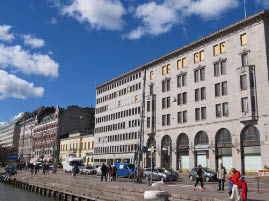
Helsinki |

Helsinki |

Helsinki |

Helsinki |

Helsinki |

Helsinki |

Helsinki |

Helsinki |
After our 45 minute orientation walk with Yulia, the group disperses. We continue our walk down along the ritzy Esplanade Boulevard Park. The promenade is lined with boutique shops on one side and a perfectly manicured park on the other side. (Never realized that Marimekko fabric shops hail from Finland – that was my kind of store in the 70’s.) We check the menus at the quaint cafes and find the neighborhood way too pricey for our blood especially if our bodies don’t know if it’s lunch or breakfast or whatever. Finally, about 8:30, we stop in a Chinese place to get some Wonton soup and udon noodles to share. It’s a quiet place, reasonable prices and more than adequate food.

Helsinki |

Helsinki |

Helsinki |
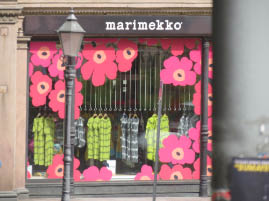
Helsinki |
We’re back at the room before 10 p.m. – still light outside. The room is equipped with heavy curtains and shades to create nighttime darkness for this season of the “white nights.” In spite of the endless, sleepless hours on the plane and in airports, I am rearing to go. I am in hyper mode as if I am on steroids. We are so happy to be here and to be starting a brand new adventure. Finally, after some drugs, my body finally calms down and I get some sleep.
June 16 – Monday--Helsinki
At 5 am, I am jolted awake. I miss-read my watch and think it says 7 a.m. so I go into overdrive getting ready for breakfast. Bill hears me stirring and asks what Iím doing. Itís then that I learn the real time is 5 a.m. At this point, thereís no going back to bed, so I go downstairs to a lonely, sad sack gym in the basement and do some treadmill and bicycle action. It is indeed an altered universe for me.
Finally, souls begin to wake up and start the day. We go down for a most delicious breakfast at 7. We hook up with our neighbors, Jill and Ken (Walnut Creek) and have a delightful breakfast.
At 8:30, we have an orientation meeting with Yulia, our guide. She takes care of business in a most lovely way. Our tour bus picks us up at 9:45. Christina, our local guide, is full of fun and facts delivered with a wonderful, off-the-wall sense of human. It’s going to be a good day – Plus the weather is beautiful.

Yulia and Christina |
We learn that Helsinki is one of the newer cities in Europe. Its historic center dates from the early 19th century when Russia ruled Finland and selected this city as the country’s new capital. We drive by the Market Square (where we hung out last night) and then drive along a long coastline packed with one gigantic cruise ship after another spewing out hundreds of passengers onto the streets of Helsinki.
We make our first stop at Senate Square – Helsinki’s Times Square where the city holds big celebrations – like New Year’s Eve. More importantly, The Square is the city’s center for arts, culture, religion, politics and education. It’s bound by four grandiose buildings -- Helsinki Cathedral (Evangelical Lutheran Church); Government Palace; the University of Helsinki; and the National Library of Finland (also houses the Helsinki Museum – sorry we missed that one). I like that church, especially in the brilliant sunlight. Built from 1830-1852 as a tribute to Tsar Nicholas I of Russia, it was also known as St Nicholas' Church until 1917 when Finland got its independence from Russia.
A statue of Russia’s Tzar Alexandra II riding on a horse stands in the center of Senate Square. He wasn’t very popular in Russia – in fact, he was assassinated (in Russia by a Russian), but the Fins loved him. He gave them their freedom in the late 1860’s. The square is designed in the neoclassical architecture, looking more like St. Petersburg than anything else in Finland. It’s interesting to note that much of the movie “Reds” with Diane Keaton and Warren Beatty, was shot in Senate Square. During the Cold War era, it wasn’t possible to go to Russia to shot on location, so Helsinki, St. Petersburg’s look alike, worked just fine.

Helsinki Cathedral |

Statue of Russia’s Tzar Alexandra II |

Senate Square |

Senate Square |

Senate Square |

Senate Square |
We drive by building after building – post office, condos, department stores, government office buildings, museums, opera houses etc. – old and new buildings, conservative / traditional mixed in with some “out-there” structures, but blending perfectly into a unique Helsinki classy style.
We see an Olympic stadium completed in 1938. The stadium was built to host the 1940 Summer Olympics, but the games were cancelled due to World War II. Finally, the 25th Olympic Games were held in this stadium in 1952. Christina, our guide, points out a nude statue of Paavo Nurmi, "The Flying Finn." He won nine gold and three silver medals in his twelve events in the Olympic Games. She says their running hero never ran in the buff, but the artist took liberties with the statue to give Paavo that Greek flare. We drive by more aging Olympic stadiums built for the 1980 games. (The US boycotted the 1980 games - Remember Jimmie Carter?)
We drive to a park where the Russians diplomats go on holiday. Views of the rocky coastline with scattered islands beyond are breath-taking. We get off the bus and gather under a tree. Yulia uses this moment for an “ice breaker” and asks each of us in the “Blue” group (Yeah Blue Group) to tell something about themselves. I like the comments and can tell this is a lovely group with some amazing people. Yulia ends by quoting Voltaire – something like “Travel not to discover new land – but to see with new eyes.” A perfect bounding moment.
We return to the city and go down a road to see some wowie-zowie glass buildings – very Avant Guard. The newspaper building is pure glass with only bicycles parked out in front.

Newspaper Building |

Newspaper Building |

Newspaper Building |

Helsinki |
We make a water / bathroom stop at the Music concert hall – another knock your socks off building. The art and beauty surrounds you on every corner in Helsinki. Out front is a strange sculpture depicting a giant fish out of water. Also out front is a funky funky design of a Donald Duck type character.

Music Hall |

Music Hall |

Music Hall |

Music Hall |

Music Hall |

Music Hall |
We stop at a monument to honor the national composer Jean Sibelius (1865–1957). He wrote the Finish national anthem and inspired the Finnish people to dream of having their own country and their own independence. A woman, Eila Hiltunen, was selected to design the monument after a national competition. Her first stab at the job was anchoring a grouping of over-scaled organ pipes into an outcropping of rocks so that visitors could stand under the pipes and hear the sounds made from the wind. The concept made sense because Sibelius derived the inspiration for his music from nature. However, the project was very controversial, dividing the Finnish people into 2 groups – conformists who wanted some sort of figure, and modernists who leaned toward the abstract floating organ pipes. The end result was two monuments -- an abstract and a likeness. As a compromise, Eila Hiltunen added Sibelius’s head on a corner rock wall. The head looks more like Omar Sharif than Sibelius. Today, the crowds are awed and charmed by such a creative design. I like seeing the visitors playful and having fun with the floating pipes. The only ones that weren’t charmed by the monument were a couple of bored school kids playing stupid pieces – one on a violin and one on a recorder -- and getting tips in spite of their lack of talent and energy.

Sibelius Monument |

Sibelius Monument |

Sibelius Monument |

Sibelius Monument |

Sibelius Monument |

Sibelius Monument |

Musician in from of Sibelius Monument |

Seagull in front of Sibelius Monument |
We learn from our guide, Christina, that Fins are relaxed people who have a high standard of living and a high value for enjoying life. They pay about 25% of their income in taxes and have socialized health care. They love their saunas and are not ashamed of their bodies. (Even the last prime minister went swimming in the buff.) Fins are practical people and will do what they must to survive. The sided with Germany during WWII but the government did not exile their Jewish population to the concentrations camps.
We say good-bye to Christina and the bus driver (and hand over the tip – well worth it) and head to a place on Market Square for lunch. Just opening last week was The Old Market Hall (1888). It is newly refurbished to hold stall after stall of delectable foods – lots of choices, lots of good food. We buy a sandwich and a beer at one of the stalls and find a table. Freddie and Terry join us for lunch. The rains came pouring down as we dine.

Market Square |

Market Square |

Market Square |

Market Square |
After lunch, the rains subside and Terry and Freddie join us as we take a short ferry ride to Suomenlinna Island. Most of the buildings on the island date back to when Finland was ruled by Sweden and by Russia. The island is a perfect location to guard the harbor of Helsinki. The island is also home to a 250-year old naval fortress, also known as Suomentinna. Construction on the fort begun in the 1700’s when Finland was under Swedish rule and expanded in the 1800’s under Russian rule. It is one of the seven UNESCO’s World Heritage Sites in Finland.
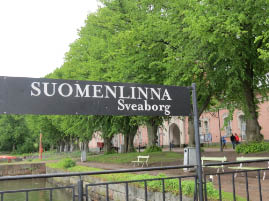
Suomenlinna Island |

Suomenlinna Island |
Only a 20-minute ferry ride from Helsinki’s Market Square, Suomenlinna Island looks and feels like a place from an old story book. Its forts and old prison endured a violent history, but today it feels oh so peaceful. It’s strange that about 800 residents live here, absorbed into the old buildings. Kids are born and raised here, play and go to school here, and that adults commute for work in nearby Helsinki. Nice life!
Lucky us got the last English speaking tour of the day. There are only 6 people on our tour and the guide is good. She tells us that the architect of the fort was not formerly educated, but learned about fort designs from his time in the military. He was also a friend of the Swedish King, who helped him land the job. In fact, the king liked him so much that when the architect died, the king designed his head stone – rather ugly.
The fortress was not an easy project to build and conditions were awful for the soldier workers – They were paid very little and had to sleep 2 to a bed. When they complained, the Swedish king said he would make them sleep 3 to a bed so they shut up. Finally, as a perk, management offered to give everyone who worked 2 extra hours a day (12 hours instead of 10 hours) a pint of beer. The beer flowed as the walls went up faster.
Our guide walks us to a Dry Dock, added later to build and repair boats – very impressive. Some serious battles were held here. Sometimes the citizens of Helsinki, just a stone’s throw away, would make a picnic on their banks to watch “the fireworks” from the artillery on the island. One story involved a Finnish General. He was believed to be bribed by the Russians and handed over the island without a fight. Later, he retired with a nice lump sum of money from the Russians.
Later, a prison was built here for the really bad guys. Of course, the prisoners were treated horribly.
We walk to the edge of the island where the coastline is littered with old canons. Here we get a lovely view of Helsinki. This place is much too beautiful for war.
Here are some scenes from that peaceful island:

Suomenlinna Island |

Suomenlinna Island |

Suomenlinna Island |

Suomenlinna Island |

Suomenlinna Island |

Suomenlinna Island |
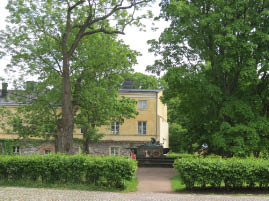
Suomenlinna Island |

Suomenlinna Island |

Suomenlinna Island |

Suomenlinna Island |

Suomenlinna Island |

Suomenlinna Island |
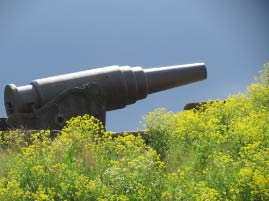
Suomenlinna Island |

Suomenlinna Island |
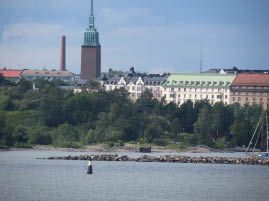
Suomenlinna Island |

Suomenlinna Island |

Suomenlinna Island |

Ferry |
We board the ferry and arrive back at the city just as the sky opens up again. To get out of the heavy rain, we go back to our hotel room. After the sky clears up again, we walk back to Senate Square to catch the Helsinki Cathedral play its daily music from the bell tower precisely at 5:49 pm.
The music, drowned out by the street traffic, was nothing to write home about – but getting out in this magnificent city again was lovely. Freddy and Terry arrive at the square so we walk back to the hotel together.

Senate Square |

Lutheran Church |

Lutheran Church |

Senate Square |
We have dinner at the hotel and sit with Bob and Joan Field. Delicious salmon dinner and fun conversation – and the start of a very nice friendship. We go back to the room to calm ourselves down from all the excitement and pretend its dark out (NOT)!

Bob and Joan |
June 17 – Tuesday – Helsinki to Tallinn, Estonia
Didn’t get much sleep.
After a nice breakfast, Bill and I grabbed the #3 tram and ride in a figure 8 through the city. We see a lot of the things we learned about the day before. The weather is awful – chilly and raining off and on. Here are some scenes from our tram excursion.

#3 Tram Loop |

#3 Tram Loop |

#3 Tram Loop |

#3 Tram Loop |
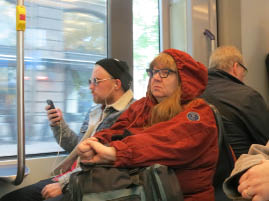
#3 Tram Loop |

#3 Tram Loop |

#3 Tram Loop |

#3 Tram Loop |
Our personal tour on the tram ends back at Market Square. We entertain ourselves with all the amazing sights down by the water.

Helsinki Harborside |
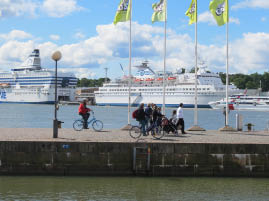
Helsinki Harborside |
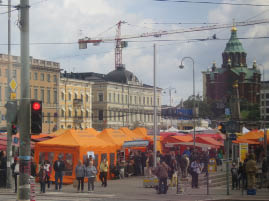
Helsinki Harborside |

Helsinki Harborside |

Helsinki Harborside |

Helsinki Harborside |

Helsinki Harborside |

Helsinki Harborside |
After our stroll through the Market Square, we visit the Uspenski Cathedral (Eastern Orthodox - 1868). It sits up on high granite boulders and overlooks the city and claims to be the largest Orthodox church in Western Europe. When we arrive, the place is packed with tour buses and tourists -- mostly Chinese.

Uspenski Cathedral |

Uspenski Cathedral |

Uspenski Cathedral |

Uspenski Cathedral |
When we have enough of the crowds, we walk back to our hotel, stopping in at the corner store for some drinks. In our room, we watch the rain come down as we munch on sandwiches we made from the breakfast buffet.
We put our luggage out of the room by 12:00 – the bus leaves at 1. We stop at the Temppeliaukio Kirkko (Church IN the Rock). The church in the rock is a very untraditional Lutheran church constructed between 1968 and 1969. Its circular dome is embedded in solid rock reaching far below ground level. Looking much like a spaceship, it’s an engineering marvel. The concave glass and copper roof emerges from the ground and is the only part of the building that can be seen from the outside. The landscape around the outside of the church is stark and lunar in appearance. Two young architects, brothers Timo and Tuomo Suomalainen, won a competition for the design. The acoustics are incredible. We listen to a woman playing on a grand piano that puts your soul in a beautiful place. The place is used for concerts even though it still functions as a place of worship. The inside design is clean and unadorned – no altar; the pews are made of light birch wood; and the walls are jagged rock. Glass panels perfectly placed in the copper roof allow for the most beautiful natural lighting. Never seen any church quite like this before.

Temppeliaukio Kirkko (Church in the Rock) |

Temppeliaukio Kirkko (Church in the Rock) |
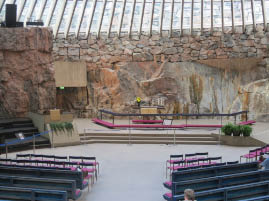
Temppeliaukio Kirkko (Church in the Rock) |

Temppeliaukio Kirkko (Church in the Rock) |

Temppeliaukio Kirkko (Church in the Rock) |

Temppeliaukio Kirkko (Church in the Rock) |

Temppeliaukio Kirkko (Church in the Rock) |

Temppeliaukio Kirkko (Church in the Rock) |

Temppeliaukio Kirkko (Church in the Rock) |

Temppeliaukio Kirkko (Church in the Rock) |
After our pleasant, meditative experience in the spaceship church, Yulia gathers us up, loads us on the bus and delivers to the Old Market Building on the Market Square for lunch. Since Bill and I ate there yesterday and already consumed our sandwiches from breakfast, we walk down in the rain to get some so-so ice cream.
We gather, load onto the bus and head for the SuperStar ferry. Our destination is across the Gulf of Finland to Tallinn, Estonia’s capital city. It is quite a process getting on the ferry. I wear my backpack packed with tour books and my computer plus a lot of other unnecessary stuff. The ferry is late and we board about 4:30 and head for the bar on the 7th floor. The tables, all facing the bow, are arranged in a semi-circle stair step configuration. It is lovely. We end up sharing our table with Jill and Ken. I like Jill a lot – She reminds me of Billie McKig. We drink some beer. Jill gets a little seasick. Then Jill and I hit the stores while Bill and Ken have political discussions. The ferry arrives at the Tallinn dock about 7:00. We meet Yulia in the ferry lounge and then we load back on our bus with Alexander as our driver.
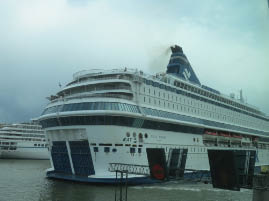
Ferry to Estonia |

Ferry to Estonia |
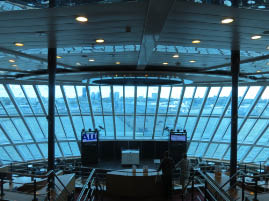
Ferry to Estonia |

Ferry to Estonia |

Ferry to Estonia |
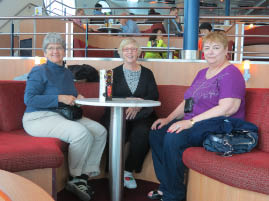
Ferry to Estonia |

Ferry to Estonia |

Ferry to Estonia |
ESTONIA: The Hotel Euroopa is just a stone’s throw away from the ferry landing. We arrive at the hotel and only have a few minutes to settle into the room before we meet again with Yulia for an orientation walk into the town of Tallinn. The room is great with a very nice view of the adjacent marina and the charming little town in the background.

Hotel Euroopa |
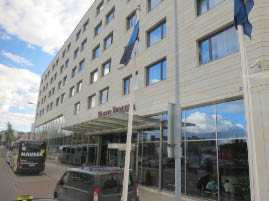
Hotel Euroopa |

Hotel Euroopa |

Tallinn
|
Yulie walks us from the hotel through Tallinn’s modern buildings and then we head to the main gate of the old Medieval Tallinn, a UNESCO World Heritage Site. The town is filled with fortresses, castles, cathedrals, gates, moats and drawbridges. It looks like a place where Shriek would live. This is better than anything Disney could do. The stalls of flowers that greet us are breath-taking. I run around with my camera, giddy with excitement.
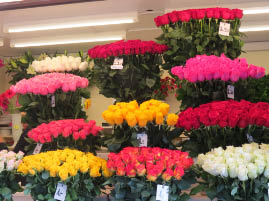
Tallinn |

Tallinn |
Yulie points out some of the landmarks and then suggests some places to eat. The group gravitates to the “fun” tourist spots where jousting is conducted during dinners of elk soup. Bill, with his Trip Advisor research of the local restaurants, nixes these ideas so we head off across the main square to a little tucked away place that comes highly recommended. Turns out, it is booked for the next week – but Plan B is only a few doors down and proves to be delightful.

Tallinn |

Tallinn |

Tallinn |

Tallinn |

Tallinn |

Tallinn |
We dine in a wonderful old medieval place -- Von Krahli Aed on Rataskaevu 8 – 10123 Tallinn. We are happy campers and have a lovely, quiet dinner, just the two of us – fish for Bill, lamb for me and a killer cheese cake with berry sauce to share.
We walk back to our hotel about 10:30 or 11 – the sun still shining brightly. This is what they call “white nights.” We close our heavy blinds to make ourselves fall asleep. Glad to be here.
P.S. We learn that Tallinn is the leader in the new technology game – Skpe was created right here!
June 18 – Wednesday – Tallinn
We wake up at 7 after a wonderful sleep – Thank you Jill for sharing your sleep meds.
We get to breakfast about 7:45. The place is packed and we must find our way through new and strange breakfast buffet tables. Luckily we find a place to sit next to Bob and Joan.
We load onto the bus at 9:30 for a guided city tour. The weather is not cooperating. It is cold, rainy and blustery. The first part of this morning’s tour is mostly a drive-by with commentary within the confines of the warm and toasty bus. Julia is our guide. Her English is terrific (and hypnotic). Her knowledge is amazing, but she seems to have a serious case of job burn-out. The group sensed it and tuned her out as well.
We drive quickly through the downtown area with its strange mix of old buildings and way out glass structures passing for buildings. The area just doesn’t have the style and design of Helsinki.

Tallinn |
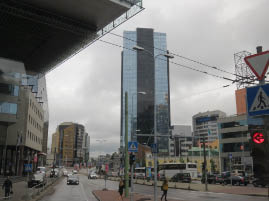
Tallinn |

Tallinn |

Tallinn |
We stop at Hirve Park, an outdoor open concert hall where greats such as Lady Gaga have performed. It was here in 1987 people came to openly protest against the Soviet domination for the first time. An oversized bronze figure of Gustav Ernesaks (1908-1993) sits on the ground facing the concert hall. He was one cool Estonian composer and choir leader who wrote the unofficial anthem of Estonians during the Soviet era. Known as “the father of singing,” he was one of the driving forces behind the national song festival. Famous nationalist meetings were held here which played a huge role in changing the country's history. The park was crowded during those times with a “Singing Revolution” calling for Estonia's freedom. I love that Estonia fought for its independence by having midnight singing gatherings. Of course, everyone waited in line to have their picture taken with Gustav. It is cold and blustery so Gustav didn’t mind sitting on the ground, but the rest of us are miserable outside. We are all happy to get back on the bus.

Hirve Park |

Gustav Ernesaks |
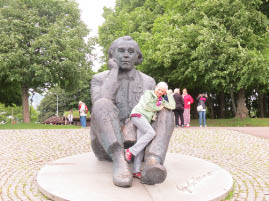
Gustav Ernesaks |

Gustav Ernesaks |
We make a drive-by stop at some important co-ed convent where both nuns and monks hung out. Then we had a bathroom / snack stop at the ferry terminal before heading into the old town.
Estonia -- Orientation
Tallinn’s Old Town is still encircled by city walls, punctuated with many stone towers rising above red-tiled roofs. Within the walls, the streets are pretty much like they were when the Danish rulers built them in the 13th century.
The Old Town is made up of 3 areas –1) Upper Town on Toompea Hill, 2) the Lower Town and 3) the belt of fortifications (which today are parks). The network of streets date from 11–15th centuries and the buildings are mostly from the 14–15th centuries. 80% of the buildings still standing today in the Old Town are from the Middle Ages. Because limestone was the main building material the town didn't burn down.
In the Lower Town, the 6000-year-old Town Hall – best preserved of its kind in northern Europe – has a tower that shoots up over the Town Hall Square (Raejoka plats). The Upper Town is on Toompea hill with two remaining landmarks that originated in the 13th century. Toompea Castle is now the meeting place for the Estonian Parliament. The Dome Church is Estonia’s largest Lutheran sanctuary.
The city’s historic buildings reflect the prosperity in the 14th – 16th centuries. Under German control, Tallinn flourished as a trade port. Later, the Swedish and Russian rulers left their marks on now quaint and charming Tallinn – a town where surely Shiek must dwell. |
We start at the upper town. Our group is fitted for ear pieces (whisper phones) which work rather well. When I get out of ear shot, I frantically look for the group. I accidently join a couple of groups – hey all of us old retirees look alike. The place is packed full with us aged baby boomers. Walking through the Old Town, trying to stay with the group and trying to gather some information isn’t all that easy.
In spite of the crowds, I catch a few buildings on our walk following our speeding guide carrying a piece of blue (for the Blue Team). We pass by castle walls, cathedrals, and guild houses of the brotherhood. I caught a quick look at the first public school of its kind. Started in 1789, it operated until 1939 when it was closed for World War II. Schools came thanks to the Pope.

Our Guide in Tallinn |
We snake our way through the crowds up Cathedral Hill. We walk by an onion-domed Russian Orthodox Church built in 1900 and named Alexander Nevsky Catherdral after the Russian hero who defeated the Teutonic Knights in the thirteenth century. This 19th century Russian orthodox cathedral with the country's largest bell symbolizes the centuries of Russification endured by Estonia. Julie, our guide, whizzed by the church.
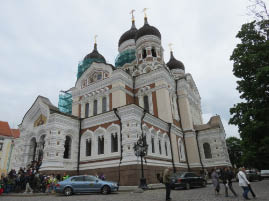
Russian Orthodox Church |
We stop in at St. Mary’s Church (Dome Church), the oldest church in Tallinn and Estonia’s largest Lutheran sanctuary. This gleaming, white church is the main Lutheran church in Estonia. Established before 1233, it was the church of the elite, German nobility and also the burial place for noble families, explorers and leaders since the 13th century. Most of the bodies lay under the church floors. At one point in history, a decree went out forbidding the church to bury anyone else – guess they ran out of room for the bodies. I think the elaborately wooden carved family crests (coat of arms for individual church members) covering the walls is the church’s most interesting feature. I also like the tomb of a Scottish Admiral from the Russian Navy who wanted to be buried near his student – don’t know if I got that story quite right. Our guide dashed through the church and through the information. Those of us who didn’t tune her out got headaches trying to keep up.

St. Mary's Church |

St. Mary's Church |

St. Mary's Church |

St. Mary's Church |
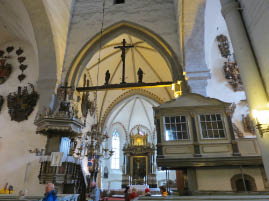
St. Mary's Church |
Next stop is a large viewing area where one could see a panoramic of the whole area. Amazing!

Tallinn |

Tallinn |

Tallinn |
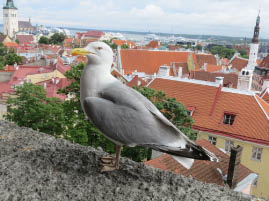
Tallinn |
Next we pass through a narrow downhill walkway, called walk of anger, to the lower town (which actually looks older because the buildings were made of limestone and didn’t burn done like the town above). Julia tells us about the great struggles between the upper and lower towns -- rivalries and feuds and decades of grudges. The upper town had slaves. If they escaped and could hide out in the lower town for one year and one day, they would be free – Free, that is, to work for low wages for the lower towns folk (who hid them).

Tallinn |
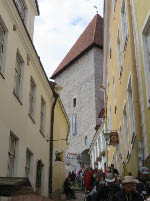
Tallinn |
Julia points out a garden that was planted after the WW II bombs wiped out some buildings. In the garden sits a monument to Eduard Vilde (1865 -1933). He is credited with being the country's first professional writer. He was also a diplomat. (I passed by that garden many times afterwards and always thought about those awful bombs dropping out of the sky. It is a peaceful place now.)

Tallin Garden |

Monument to Eduard Vilde |
We end the tour in the main town square in front of the Dragon Town Hall. Julia, the guide, was glad to be rid of us. There is a lot of activity in the main square with a huge market and hordes of tourists. We are happy because the sun is shining and the gray skies are turning blue.

Tallinn Town Square |

Tallinn Town Square |

Tallinn Town Square |

Tallinn Town Square |
We pay our tips to Julia and everyone goes off on their own. We hook up with Bob and Joan and head for the Tourist Information Center to get some advice on what to do in town for the afternoon. The kid at the desk suggested an Irish pub a few blocks away that is cheap and good – and has a very nice discount on the beer. We take the recommendation, enjoy the lunch – in fact Bill and Joan go nuts over the soup. However, the place has strange, unappetizing paintings on the wall and the bathroom sells Billy Boy condoms. In spite of this quirkiness, we have a lot of laughs and go away a little tipsy.

Billy Boy Condoms |

Painting at Pub in Tallinn |
Maybe it was the beer, or the winding cobble streets, but “LOST” we are as we try to find the “Kiek in de Kok” – for a tour inside the walls of the Bastion. When we finally stumble across it, we learn that all tours are booked for today, so we’ll come back tomorrow. Then we walk along the top of the fortress wall – later we learned that we walked on the wrong wall.

Kiek in de Kok |

Kiek in de Kok |
On our way home, we stop in at St. Olav’s Church, a very sparse church but with a high tower and great views. Named after King Olaf II of Norway, it was built in the 12th century by the old Tallinn's Scandinavian community before Denmark conquered Tallinn in 1219. Once upon a time, this old Gothic church was considered to be the tallest building in the world. Bob, Bill and I paid 2 Euros to climb 238 steps to the top. (Joan waits patiently in the church babying her back.) It is well worth the climb -- the views were grand.

St. Olav’s Church |

St. Olav’s Church |

St. Olav’s Church |

St. Olav’s Church |

View from St. Olav’s Church |

View from St. Olav’s Church |

View from St. Olav’s Church |

View from St. Olav’s Church |

View from St. Olav’s Church |

View from St. Olav’s Churchh |
We walk back to our hotel with about an hour to spare. At 5:30, we met for tea, coffee and cookies before our hour lecture on life in Estonia. We all were disappointed when Julia, our guide from the morning, shows up. However, now she is a different person. Gone is the burn out. She shares insights of her new fledging country telling us that the education system is not nearly as good since the fall of Communism. She was a wealth of info – geographic, political and economic. None of us want her to leave when it was time for dinner.
We have a simple meal in the hotel with Fasel and Janet. Janet’s a Brit and Fasel’s an Arab -- They’re a darling couple.
Back at the room, I work on the journal. It’s 11 pm and the sun still shines!
June 19 – Thursday – Tallinn on our own with Joan and Bob
We wake up early with not much sleep. I drag myself out of bed and get ready for breakfast. I make a little sandwich to go to for later. We come back to the room by 7:30 and I spend a couple of hours finishing off the rough edges of my journal.
The group leaves for an optional bus trip to an Estonian dairy farm that produces cheese and yogurt. We’d rather explore Tallinn more so we stay behind with Bob and Joan. At 9:45 a.m., we arrange for a van to take us to Kadriorg Palace, a palace built by Peter the Great in 1718 to honor his wife Catherine. It now houses the foreign art collection of Estonia, displaying paintings from the 16th to 20th centuries as well as prints and sculptures. We like the cozy little palace with its grand rooms and lovely gardens with fountains out back.

Kadriorg Palace |

Kadriorg Palace |

Kadriorg Palace |
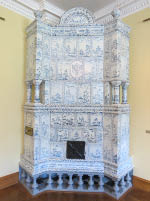
Kadriorg Palace |

Kadriorg Palace |

Kadriorg Palace |
The current art show features black and white silhouettes. Amazing how those flat, black shapes convey so much life.

Kadriorg Palace |

Kadriorg Palace |

Kadriorg Palace |

Kadriorg Palace |
We see a painting of Peter the Great – He looks frail and weak … but looks can be deceiving. He was one, in charge leader and quite a guy.

Kadriorg Palace |

Peter the Great |
We find a lovely middle aged English woman who is openly turned on by the man in one of the paintings. I take a photo of her with her “lover.” We have quite a few laughs over that one. This place makes us oh so very playful.

Kadriorg Palace |
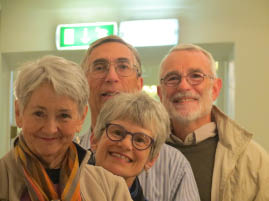
Nancy, Bob, Joan, Bill |
After the palace, we walk in the gardens and then stop by the Presidential house and check out the 2 very bored looking guards.

Kadriorg Palace |

Kadriorg Palace |

Kadriorg Palace |

Kadriorg Palace |

Kadriorg Palace |

Kadriorg Palace |
We amble on down the road in search of the Kunstimuuseum (Kumu) Art Museum. It is a new, very spacious and modern art gallery – Estonia’s premier art museum. The complex is a modern architectural masterpiece. Curves and sharp edges mark out the copper and limestone structure, which is built into the side of a limestone cliff. I love all 5 floors of it. The paintings and sculptures are delightful. The four of us run around snapping photos and having fun with the art. We eat lunch in the Café – Bill and I have a beer and a cheese / tomato Panini.

Kunstimuuseum Art Museum |
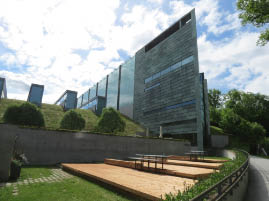
Kunstimuuseum Art Museum |

Kunstimuuseum Art Museum |

Kunstimuuseum Art Museum |

Kunstimuuseum Art Museum |
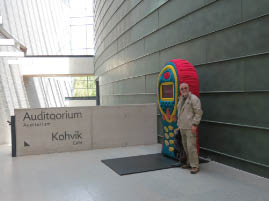
Kunstimuuseum Art Museum |

Kunstimuuseum Art Museum |

Kunstimuuseum Art Museum |
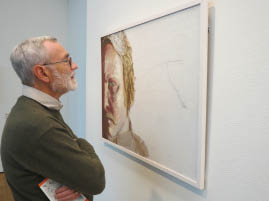
Kunstimuuseum Art Museum |

Kunstimuuseum Art Museum |

Kunstimuuseum Art Museum |

Kunstimuuseum Art Museum |

Kunstimuuseum Art Museum |

Kunstimuuseum Art Museum |

Kunstimuuseum Art Museum |

Kunstimuuseum Art Museum |

Kunstimuuseum Art Museum |

Kunstimuuseum Art Museum |

Kunstimuuseum Art Museum |

Kunstimuuseum Art Museum |

Kunstimuuseum Art Museum |

Kunstimuuseum Art Museum |

Kunstimuuseum Art Museum |

Kunstimuuseum Art Museum |

Kunstimuuseum Art Museum |

Kunstimuuseum Art Museum |

Kunstimuuseum Art Museum |
Full and tired, we trudge down the road to find trolley #1 or #3. When the 4 of us get on the trolley, we can’t find a place to deposit our fares. I think I spot it, then realize what I see is the trash can. Luckily I have trouble putting my euros in the trash container. The folks on the trolley enjoy our goofy antics … then one person comes forward to give us a hand.
We get off the trolley at Viru, one of the main gates to the Lower Town. We are on a mission to visit Kiek-in-de-Kok (Look-Into-the-Kitchen), a bastion built in 1470. At that time it was the tallest building in Estonia and earned its name because the watchmen could peer into the kitchens of the houses below. Like yesterday, we have trouble finding the place in this medieval town with its narrow, winding, maze of streets. After much angst, we find the “Kiek-in-de-Kok” and buy our tickets for the underground tour.

Kiek-in-de-Kok |

Kiek-in-de-Kok |

Kiek-in-de-Kok |

Kiek-in-de-Kok |
Our guide takes us down below the narrow tunnels to tell the story of the bunkers. We learn that over the years, the underground passage was used for such things as housing for the homeless, Punk Rockers / Musicians’ hangout, bomb shelters during WWII, place for kids to find their lost pets (e.g. a lost cat), religious retreat, prison, storage area, etc. In 2017, the bastion will be celebrating its 1000 birthday – quite a place.

Kiek-in-de-Kok |

Kiek-in-de-Kok |
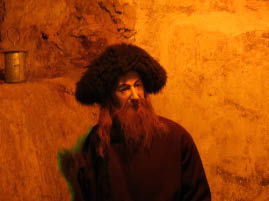
Kiek-in-de-Kok |
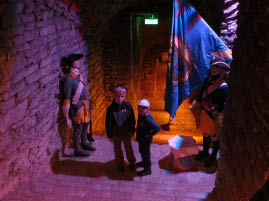
Kiek-in-de-Kok |

Kiek-in-de-Kok |

Kiek-in-de-Kok |
After emerging from the underground, we buy tickets to the tower section to learn more about the history of Tallinn. We see the weapons and torture equipment and look out at the views from the tower imagining what it must have been like to peek into the kitchens of the houses back them.

Kiek-in-de-Kok |

Kiek-in-de-Kok |

Kiek-in-de-Kok |

Kiek-in-de-Kok |

Kiek-in-de-Kok |

Kiek-in-de-Kok |

Kiek-in-de-Kok |

Kiek-in-de-Kok |

Kiek-in-de-Kok |

Kiek-in-de-Kok |

Kiek-in-de-Kok |
A way cool café is on the top floor (floor #6) of the tower. The views are spectacular so I snap a few photos from the tower, then we rest our weary bones. We have tea at the café before we go back down stairs to buy tickets for the outside castle walk. We are foiled because a set of doors is locked – no electricity today, so we call it a day and head for a nice place to eat.

View from the Cafť |
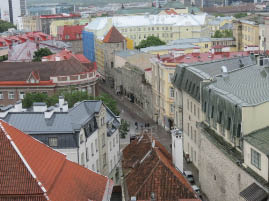
View from the Café |

The Café |

The Café |

The Café |

The Café |
We walk to a restaurant named Rataskaevu after the street it sits on near the main town square. Rataskaevu is rated the #1 restaurant in Trip Advisor. We are lucky to get seated. We have wonderful food and drink served by a delightful young waiter. We learn his life story – his mother is Estonian. His father is Italian who came to Estonia to make a fortune after the fall of Russia. (And apparently, Daddy did quite well in the Estonian restaurant business.)
We walk back to the hotel in the rain with Bob and Joan – very full, a little tipsy, and a lot tired – but happy with our wonderful day together. Back in the room, I journal like a fool, then pack my bags for an early departure to St. Petersburg in the morning. Life is truly GRAND!
June 20 – Friday – Transit Day – Tallinn to St. Petersburg
We put the luggage outside the door and go down for breakfast. Looks like a sunny day with blue skies up above – but right after breakfast, those old gray clouds roll in.
We climb on to the bus at 8 and off we go – for a projected 8-hour road trip to St. Petersburg. Alexander is a delightful bus driver and makes everything fun. He stops briefly outside Tallinn to show us the ruins of ancient gravesites that are circular. Yulia suggests that one theory is that the labyrinth design was used to keep the souls from finding their way down under.
Like all tour buses, we make a pit stop after a couple of hours and then hit the road again. The scenery is lovely – mostly a flat, tree lined 2 lane freeway with the greenest green I’ve seen in a while (especially coming from Southern California). The bus is equipped with WiFi so we can communicate with the world while we head into Russia. We get an email from Amy that says, “Say Hello to Pooty Poot.” Strange new world.

On the Road to Russia |

On the Road to Russia |
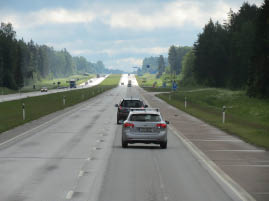
On the Road to Russia |

On the Road to Russia |
We stop for lunch in the fortress town of Narva on the Russian-Estonian border. Yulia tells us Narva was once the most beautiful town in all of Europe – even more gorgeous than Tallinn – but was completely destroyed during WW II. Damn, the bombs really do mess up the shrubbery. There is a hint of some of the former glory – but boy is it hard to see beyond all those dreadful Soviet-style buildings.
We have lunch in an old castle. The castle’s claim to fame is that is has one of the very few remaining standing statues of Stalin. He’s not a popular guy – could it be that he was responsible for killing someone in each of Russian’s families.
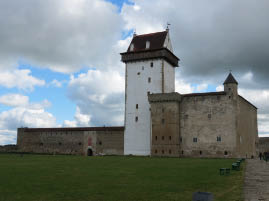
Narva |

Narva |
We go inside and sit in large uncomfortable castle chairs. The food screams “Soviet food” – watery chicken noodle soup low on the chicken and a most bland main course – schnitzel (like our chicken fried steak), potatoes and a few veggies thrown in for color. I didn’t even attempt the swishy baked apple.

Lunch at Narva |
We load back on the bus dreading the complicated border crossing into Russia. We are told NO TAKING PICTURES during the border crossing – I take that very seriously. Both Yulia and Alexander go into somber mode. A guard enters the bus and collects our passports. Then we fill out 2 separate, but identical forms. We get our passports back at another station later in the process. Alexander goes to a station to register the bus … then we all enter as a group. The goal is to gain the OK (and stamp) of a most unpleasant woman behind the window wearing a stupid t-shirt with cartoon characters embroidered on it. The whole group remains in the final room until everyone has been stamped and processed. We all breathe a collective sigh of relief when we are back on the bus and crossing into Russia. Yulia said we made it in record time – the process went perfectly today. I think it was because of our charming driver Alexander. I saw him flirting and even making a couple of those Russian Guard Gals smile – not an easy task. Thank you Alexander!
As we cross the river (and border) into Russia, we are free to take pictures again. We see about a mile of large trucks lined up, waiting to be processed to cross over into Estonia. It’s going to a long wait for them.

On the Road to St. Petersburg |
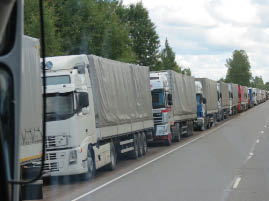
On the Road to St. Petersburg |
We have a couple more hours to get to St. Petersburg. The landscape remains flat and green like Estonia, but with a few more wild flowers scattered about. The road is a little more worn than the road in Estonia, but not bad. We see mostly rural areas until we come to the outskirts of St. Petersburg (population 5 million) – then the 2 lane roads branches out into ribbons of freeways winding over industrial areas. Finally, we cross the bridge and drive down to our boat dock and to our waiting ship – MS Tikhi Don. |











